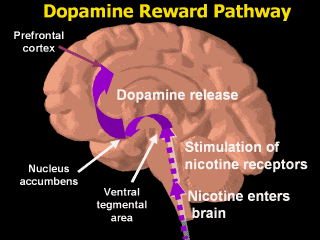| front |1 |2 |3 |4 |5 |6 |7 |8 |9 |10 |11 |12 |13 |14 |15 |16 |17 |18 |19 |20 |21 |22 |23 |24 |25 |26 |27 |28 |29 |30 |31 |32 |33 |34 |35 |36 |37 |38 |review |
 |
Drugs such as cocaine, heroin,
amphetamine, and nicotine exert profound effects on the brain. These agents
have in common the ability to stimulate the release of the neurotransmitter
dopamine in the midbrain. Dopamine induces feelings of euphoria and pleasure
and is responsible for activating the dopamine reward pathway (Leshner,
1997). The dopamine reward pathway, as depicted in this simplified diagram, is a network of nervous tissue in the middle of the brain that elicits feelings of pleasure in response to certain stimuli. The important interconnected structures of the reward pathway include the ventral tegmental area (VTA), the nucleus accumbens, and the prefrontal cortex (area of the brain responsible for thinking and judgment). The neurons of the VTA contain the neurotransmitter dopamine, which is released in the nucleus accumbens and in the prefrontal cortex. Behaviors that naturally stimulate the reward pathway include eating to relieve hunger, drinking to alleviate thirst, or engaging in sexual activity. On a primitive, neurochemical level, stimulation of the reward pathway reinforces the behavior so that it will be repeated. Obviously these behaviors are necessary for continued survival of the organism. The reward pathway can also be stimulated by drugs of abuse such as cocaine, opiates, amphetamine, and nicotine. When these unnatural stimuli trigger the reward pathway the same pleasurable feelings are elicited. Researchers believe that, with chronic drug use, the brain becomes chemically altered—transforming a drug user into a drug addict (Leshner, 1997). Consider cigarette smoking as an example. Immediately following inhalation, a bolus of nicotine enters the brain, stimulating the release of dopamine, which induces nearly immediate feelings of pleasure and relief of symptoms of nicotine withdrawal. This rapid dose-response reinforces and perpetuates the smoking behavior. This slide is made available to the public through the National Institute on Drug Abuse Web page, at www.nida.nih.gov/Teaching/largegifs/slide-9.gif. Adapted with permission by Dr. Rochelle D. Schwartz-Bloom, Duke University. Leshner Al. (1997, April). Drug abuse and addiction are biomedical problems. Hosp Pract (special report):2–4. Slide is used with permission, Rx for Change: Clinician-Assisted Tobacco Cessation. Copyright © 1999-2007 The Regents of the University of California, University of Southern California, and Western University of Health Sciences. All rights reserved. |